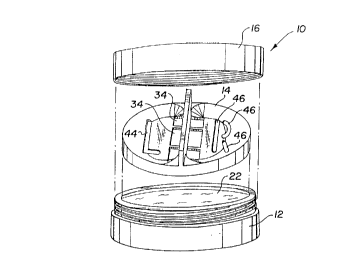Some of the information on this Web page has been provided by external sources. The Government of Canada is not responsible for the accuracy, reliability or currency of the information supplied by external sources. Users wishing to rely upon this information should consult directly with the source of the information. Content provided by external sources is not subject to official languages, privacy and accessibility requirements.
Any discrepancies in the text and image of the Claims and Abstract are due to differing posting times. Text of the Claims and Abstract are posted:
| (12) Patent: | (11) CA 2083133 |
|---|---|
| (54) English Title: | CONTACT LENS CASE |
| (54) French Title: | ETUI POUR VERRES DE CONTACT |
| Status: | Deemed expired |
| (51) International Patent Classification (IPC): |
|
|---|---|
| (72) Inventors : |
|
| (73) Owners : |
|
| (71) Applicants : | |
| (74) Agent: | FINLAYSON & SINGLEHURST |
| (74) Associate agent: | |
| (45) Issued: | 1999-09-21 |
| (86) PCT Filing Date: | 1992-03-18 |
| (87) Open to Public Inspection: | 1992-09-19 |
| Examination requested: | 1996-05-14 |
| Availability of licence: | N/A |
| (25) Language of filing: | English |
| Patent Cooperation Treaty (PCT): | Yes |
|---|---|
| (86) PCT Filing Number: | PCT/US1992/002241 |
| (87) International Publication Number: | WO1992/016123 |
| (85) National Entry: | 1992-11-17 |
| (30) Application Priority Data: | ||||||
|---|---|---|---|---|---|---|
|
A contact lens case (10) having a container (12) for
liquid solution (22), a tray (14) which fits into the container
(12) and having a substantially flat portion (26) for the
contact lens to rest on and an annular beveled outer portion
(30) for retarding the outward movement of the lens. A dividing
perpendicular bar (32) extending upwardly from the top of the
tray (14) and serves both to separate the right lens from the
left lens and to act as a handle for lifting the tray (14). The
tray (14) forms apertures (34) adjacent to or in near proximity
to the bar and other apertures (44, 46) to form the letter "L" on
one side of the bar and the letter "R" on the other side. A
removable cap (16) forms ridges on its inside to prevent the
creation of suction between it and the concave side of a lens.
Boîtier de rangement (10) pour verres de contact, comprenant un récipient (12) contenant la solution liquide (22), un plateau (14) s'adaptant à l'intérieur du récipient (12) et présentant une partie essentiellement plate (26) sur laquelle reposent les verres de contact et une partie annulaire oblique (30) qui ralentit le mouvement des verres vers l'extérieur. Une barre perpendiculaire de division (32) s'étend vers le haut depuis la partie supérieure du plateau (14) et permet à la fois de séparer le verre droit du verre gauche et, utilisée comme une poignée, de soulever le plateau (14). Ce dernier comporte des ouvertures (34) adjacentes à la barre ou à proximité immédiate de celle-ci, ainsi que d'autres ouvertures (44, 46) formant la lettre ''L'' d'un côté de la barre et la lettre ''R'' de l'autre côté. Un couvercle amovible (16) présente des nervures à l'intérieur, afin d'éviter la création d'une force d'aspiration entre ledit couvercle et le côté concave d'un verre.
Note: Claims are shown in the official language in which they were submitted.
Note: Descriptions are shown in the official language in which they were submitted.

For a clearer understanding of the status of the application/patent presented on this page, the site Disclaimer , as well as the definitions for Patent , Administrative Status , Maintenance Fee and Payment History should be consulted.
| Title | Date |
|---|---|
| Forecasted Issue Date | 1999-09-21 |
| (86) PCT Filing Date | 1992-03-18 |
| (87) PCT Publication Date | 1992-09-19 |
| (85) National Entry | 1992-11-17 |
| Examination Requested | 1996-05-14 |
| (45) Issued | 1999-09-21 |
| Deemed Expired | 2004-03-18 |
There is no abandonment history.
| Fee Type | Anniversary Year | Due Date | Amount Paid | Paid Date |
|---|---|---|---|---|
| Application Fee | $0.00 | 1992-11-17 | ||
| Maintenance Fee - Application - New Act | 2 | 1994-03-18 | $50.00 | 1994-03-18 |
| Maintenance Fee - Application - New Act | 3 | 1995-03-20 | $50.00 | 1995-03-16 |
| Maintenance Fee - Application - New Act | 4 | 1996-03-18 | $50.00 | 1996-03-12 |
| Registration of a document - section 124 | $0.00 | 1996-05-30 | ||
| Maintenance Fee - Application - New Act | 5 | 1997-03-18 | $75.00 | 1997-03-17 |
| Maintenance Fee - Application - New Act | 6 | 1998-03-18 | $75.00 | 1998-03-11 |
| Maintenance Fee - Application - New Act | 7 | 1999-03-18 | $75.00 | 1999-03-15 |
| Final Fee | $150.00 | 1999-06-15 | ||
| Maintenance Fee - Patent - New Act | 8 | 2000-03-20 | $75.00 | 2000-02-16 |
| Maintenance Fee - Patent - New Act | 9 | 2001-03-19 | $275.00 | 2002-03-18 |
| Maintenance Fee - Patent - New Act | 10 | 2002-03-18 | $100.00 | 2002-03-18 |
Note: Records showing the ownership history in alphabetical order.
| Current Owners on Record |
|---|
| IVES IDEAS, INC. |
| Past Owners on Record |
|---|
| IVES, RAY C. |